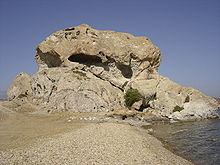Patmos
![]()
The title of this article is ambiguous. For other meanings, see Patmos (disambiguation).
f9f10f8
Patmos (Greek Πάτμος (f. sg.)) is a Greek island belonging geographically to the Southern Sporades and politically to the Dodecanese archipelago in the Eastern Aegean. Together with some uninhabited islets, it forms a municipality (Greek δήμος dimos) in the South Aegean region. The island is 34.14 km² in size and is hilly rather than mountainous, the highest elevation reaching 269 m. The vegetation is very sparse, there are hardly any trees, only the typical phrygana covers the land. Patmos has about 3047 inhabitants (2011).
Despite its small size, Patmos is one of the more important islands in the Aegean: the presumed site of the creation of the Revelation of John, it is the location of one of the most important monasteries of the Greek Orthodox Church and is connected to the rest of Greece by several highly frequented ferry lines. Patmos is considered the 'Holy Island' and is the destination of several major annual pilgrimages by devout Orthodox Christians, such as at Easter. Due to this lively stream of visitors, the ferry connections were also expanded early on, and so Patmos was able to participate in the tourist development of the Greek island world, despite the lack of an airport, without having to experience the excesses of forced mass tourism.
Localities
Scale
In an elongated bay as an ideal natural harbour lies the port of the island, here the tourist accommodation and commercial enterprises are concentrated. Venetian elements can be found in the older buildings on the harbour front. Due to the high frequency of arriving and departing ferries, a bustling atmosphere surrounds the town. During the Italian occupation of the island, Skala became the location of the post office, customs office and military administration. Due to these economic and political factors, the place - formerly only stairs (Σκάλα) to the monastery - became the secular capital of the island.
Chora
The island's capital was built in the 12th century around the monastery of St. John. The winding streets and houses convey a Cycladic rather than Dodecanese atmosphere.
Petra and Grikos
In the south of Patmos extends a bay, which is protected by a smaller island off the coast. Within this bay rises a rock about 20 m high, which in early antiquity was most likely used as a ceremonial site, and later by pirates. The rock is littered all around with carved stairs and cavities. At the top is a cistern that still functions today. A valley opens into this cove, which still contains the original vegetation and a stream that flows all year round. Its source is enclosed by a tiny chapel where, according to tradition, the first people were baptized, who have since called themselves Christians. The chapel is halfway along the road between Grikos and Chora.
The offshore village of Grikos is a settlement that only developed around the Hotel Xenia since the Greek military dictatorship and is mainly turned towards tourism. The Hotel Xenia itself stood empty for years due to unresolved ownership issues and was subject to decay and vandalism. The hotel was rebuilt, expanded and reopened in 2010 as a luxury refurbished 5-star hotel.

The rock in the bay of Grikos

Skala, seen from the monastery of Agios Ioannis Theologos
St. John's Monastery
Dedicated to Saint John, the monastery was founded in 1088 by a monk, Blessed Christodulos, with the support of the Byzantine Emperor Alexios I, on the ruins of an ancient temple of Artemis. With its castle-like walls, it still dominates the appearance of Chora and the island. St. John's Monastery with its important library has been listed as a UNESCO World Heritage Site since 1999.
Patmos was a place of exile in Roman times, the author of the biblical revelation of John wrote down his apocalypse here in exile according to his own information (Rev 1,9 EU). Patmos is specifically named in Revelation as the place of his visions. St. John's Grotto is one of the most important shrines in Orthodoxy. It can be visited near the road from Skala to Chora.

Stairway to the monastery Agios Ioannis
Search within the encyclopedia